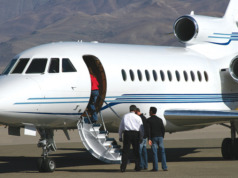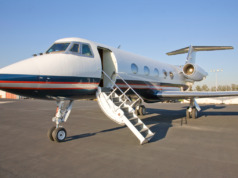The decision to borrow money or pay cash for any capital asset, especially when that acquisition is a business aircraft, may seem to be multi-faceted and complex. In actuality, the question is really quite simple − how and where can corporate funds be used to generate the greatest return?
Cash always has been, and always will be, king. But not all cash is created equal. Financial institutions commonly operate with the presumption that an accomplished businessperson can generate more revenue on the money he or she invests to grow his or her business versus using those dollars to purchase capital goods, such as new machinery, vehicles, or a business aircraft.
Therefore, using these same funds to purchase capital goods, versus other operating or marketing investment opportunities, often may not make the best financial sense. Additionally, regardless of how substantially an aviation asset enhances management and employee productivity, a business aircraft still depreciates, just like machinery or rolling stock.
In an alternative scenario, a prospective borrower may have the need for, but not the necessary reserves, to purchase a business aircraft outright. Nevertheless, where there is a strong operating and profit history, the potential exists to demonstrate the loan can be serviced comfortably out of cash flow, and still provide an adequate allowance to cover unexpected events. Also, the existence of other physical assets that can be collateralized to support the loan is usually favorable.
The Basics of Aircraft Financing Remain Unchanged
While memories of the 2008 economic downturn still loom in most loan originators’ minds, the basics of financing a business, or a business aircraft, for the most part remain unaltered. What has changed is that lenders have become much more analytical when evaluating loan applications – and they tend to stay more involved after the loan has been made.
Generally, you can count on additional, but not necessarily onerous, lender requests in order to obtain financing. For example, aircraft engines may have to be on hourly cost maintenance support programs (See: “Over and Above,” BAA Jan/Feb 2020), acceptable insurance coverage must be in place, and registration numbers cannot be blocked by flight tracking systems.
Lender verification that required appropriate maintenance is being performed at the scheduled intervals, along with monitoring the number and destinations of flights, has become much more prevalent. Periodic physical inspections of the aircraft by the financial institution granting the loan also are more commonplace.
Lenders’ perspectives of business aircraft themselves likewise have changed. Experienced aircraft finance professionals, now quite astute in the areas of market segmentation and marketplace values, no longer view aircraft simply as commodities without further scrutiny required.
Another difference is that frequently an aircraft is 1) no longer being accepted as the only collateral, and 2) valued solely on its purchase price. Banks also now calculate a loan amount based on the value for which an aircraft can be sold, versus the total acquisition cost. Finally, borrowers having equity in the aircraft is viewed positively, and often even is a requirement (See: “Structuring a Deal,” BAA Jan/Feb 2020).
Forget the timeworn, inaccurate belief that banks only loan money to those who don’t need it. Financial institutions have cash and want to do business. This desire is heightened by competition between lenders and new entrants in the marketplace.
Varying approaches to financing aircraft are taken by different lenders. A well maintained and conservatively operated aircraft that is 20, or more years old may not be an issue, particularly if the asset is part of a large fleet with good resale value, such as the Beech King Air turboprop.
On the other hand, some institutions may look only at aircraft below a certain age. Still others use the Rule of 25 (or 20, or even 15, depending on the current and projected state of business aircraft values). This approach combines the term of the loan and the age of the aircraft to determine that the result does not exceed a preset number.
While the methods that financial institutions employ to evaluate loan applications may differ, there is significant commonality. In general, loan officers will analyze:
- The borrower’s ability to service a loan/Creditworthiness
- Business operating results for the last three to five years
- Aircraft acquisition cost/Residual value at loan termination
- Market value changes and forecast (fleet, OEM, model)
- Category appropriateness/Mission fit/Comparables
- Any additional business the applicant has with a lender
- The amount of loan competition from other institutions, and
- Unique factors that may have a direct or indirect impact on the application.

Be Successful By Being Prepared
Start the application process by approaching the institution(s) that you want to consider to be your loan partner as just that – a partner. View these prospective lenders as the assets they truly are – knowledgeable resources with the expertise to guide you through the process and assist you in obtaining the best possible outcome.
A lender who is deeply involved with their client should be seen as a positive. Financial partners can assist with problem prevention, or help to identify issues early enough so that corrective action can be taken.
Don’t give them pause by what you do, or don’t do. Start by compiling your financial information into a complete and comprehensive package. Three years of history usually is the minimum time requested to review, but five years is even better.
Experienced aircraft loan professionals can provide invaluable assistance.
Cash flow (not just profit) and the type of equity a company possesses are the first two aspects lenders will review. For example, a developer with 90 percent of the corporate assets in real estate could be of concern. An economic downturn in that business segment may well create a large default potential.
Make use of the aircraft loan professionals’ expertise. Bring these individuals into the equation as early as possible to allow them help you proceed in a prudent, reasonable, and efficient manner. These experts know the financial pitfalls that can befall the unprepared or unwary. Since the conversation is free, why not have it?
Chasing the lowest rate, or focusing solely on the loan rate, is one of the biggest mistakes made. Take time to research a lender’s client service availability and quality, their business aircraft marketplace knowledge, and the institution’s financial stability. It’s only prudent to partner with those who have “been there and done that” in the aircraft financing arena, and who are aware of all the potential problems that can create major headaches. You can bank on the fact that those unforeseen issues will cost a lot of dollars and cents. That’s why choosing an experienced aircraft financing partner makes good economic sense. BAA
Steve Fushelberger is a marketing and communications consultant to the business, general, commercial, and defense aviation industries. Possessing a Commercial Pilot license, he’s held senior leadership positions at Rolls-Royce, United Air Lines, Textron Aviation, and Leonardo.






